
Walk through the logic of determining what kind of good has the most elastic demand in this video.
- Subject:
- Economics
- Social Science
- Material Type:
- Lesson
- Provider:
- Khan Academy
- Provider Set:
- Khan Academy
- Author:
- Sal Khan
- Date Added:
- 07/27/2021

Walk through the logic of determining what kind of good has the most elastic demand in this video.
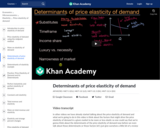
There are several factors that affect how elastic (or inelastic) the price elasticity of demand is, such as the availability of substitutes, the timeframe, the share of income, whether a good is a luxury vs. a necessity, and how narrowly the market is defined. We explore each of these in this video.
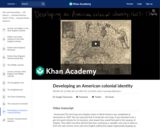
How British were the British colonies in North America in 1754? In this video, Kim discusses how the British colonies participated in political, social, cultural, and economic exchanges with Great Britain that encouraged both stronger bonds with Britain and resistance to Britain’s control.

From 1800 to 1848, the United States grew tremendously as a country, adding new territory and building national connections of business and transportation. But just twelve years later, the Civil War erupted! In this period, was the United States developing a unified national identity or a divided regional identity?

This lesson compares rational number and orders them from least to greatest using the number line. [Developmental Math playlist: Lesson 132 of 196]

This lesson demonstrates how to compare whole numbers. [Developmental Math playlist: Lesson 7 of 196]

The Paleolithic and Neolithic eras of the Stone Age. Created by Sal Khan.

The Paleolithic and Neolithic eras of the Stone Age. Created by Sal Khan.

Deësis (Christ with the Virgin Mary and John the Baptist), c. 1261, mosaic, imperial enclosure, south gallery, Hagia Sophia, Istanbul. Speakers: Dr. Beth Harris and Dr. Steven Zucker.
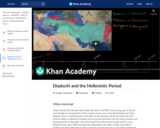
Alexander's Empire fragments into Seleucid Persia, Ptolemaic Egypt and Antigonid Macedonia (and other kingdoms) and gives rise to the Hellenistic Period.

A conversation with Jason Guberman-Pfeffer, Executive Director, Digital Heritage Mapping, Inc. and Coordinator, Diarna Geo-Museum and Beth Harris. An ARCHES video.
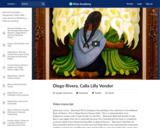
Diego Rivera, Calla Lilly Vendor (Vendedora de Alcatraces), 1942, oil on masonite, (Banco Nacional de Mexico, Mexico City) Speakers: Dr. Beth Harris and Dr. Steven Zucker.

Diego Rivera’s “Detroit Industry Murals” is a monumental 27-panel mural at the Detroit Institute of Arts that portrays the geological, technological, and human history of Detroit. Rivera was a great admirer of American innovation and both celebrates and questions its impact on society. He depicts the enormity and complexity of an automotive factory and presents those who work there as heroes who work with integrity and nobility. Watch Salvador Salort-Pons, Director at the Detroit Institute of Arts, explore what makes “Detroit Industry Murals” a masterpiece. Video by Bank of America. Created by Smarthistory.
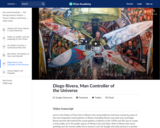
What will technology bring us? Diego Rivera, Man Controller of the Universe (or Man in the Time Machine), 1934, fresco, 4.85 x 11.45 m in the Palacio de Bellas Artes, Mexico City Speakers: Dr. Beth Harris and Dr. Steven Zucker. Created by Beth Harris and Steven Zucker. Find learning related resources here: https://smarthistory.org/seeing-america-2/

How dielectrics function in circuits. By David Santo Pietro.

An introduction to the difference between wealth and income. Created by Sal Khan.

This 10-minute video lesson provides an introduction to 2nd order, linear, homogeneous differential equations with constant coefficients. [Differential Equations playlist: Lesson 13 of 45]

This 8-minute video lesson continues the discussion from the previous video and shows how to find the general solution. [Differential Equations playlist: Lesson 14 of 45]

This 6-minute video lesson continues the discussion from the previous videos and introduces some initial conditions to solve for the particular solution. [Differential Equations playlist: Lesson 15 of 45]

This 9-minute video lesson continues the discussion from the previous videos and provides another example using initial conditions. [Differential Equations playlist: Lesson 16 of 45]